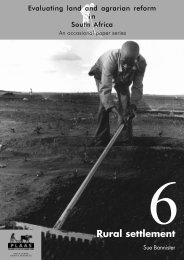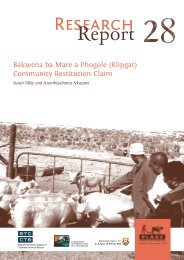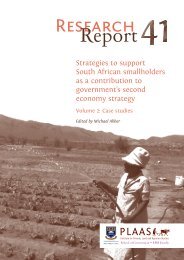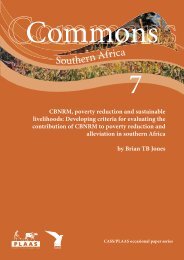A critical appraisal of South Africa's market-based land reform policy
A critical appraisal of South Africa's market-based land reform policy
A critical appraisal of South Africa's market-based land reform policy
You also want an ePaper? Increase the reach of your titles
YUMPU automatically turns print PDFs into web optimized ePapers that Google loves.
Chapter 5: The LRAD programme<br />
than that <strong>of</strong> the Land Bank-implemented<br />
projects with the average beneficiary <strong>of</strong><br />
Land Bank projects acquiring almost 12<br />
times the amount <strong>of</strong> debt. While spending<br />
more money, the Land Bank has assisted<br />
with the acquisition <strong>of</strong> a far smaller<br />
amount <strong>of</strong> <strong>land</strong> than the DLA. This is<br />
undoubtedly due to the type <strong>of</strong> projects<br />
supported and the payment <strong>of</strong> <strong>market</strong><br />
value for <strong>land</strong> acquired by the Land Bank<br />
compared to the low cost <strong>of</strong> the state <strong>land</strong><br />
that DLA acquired for some beneficiaries<br />
at less than <strong>market</strong> rates.<br />
It is interesting to note that in 8 out <strong>of</strong><br />
14 projects involving women the women<br />
have the same surname as another male<br />
project member, indicating that they may<br />
be applying as part <strong>of</strong> a family (Land Bank<br />
2003). While women end up with a far<br />
lower average amount <strong>of</strong> hectares than<br />
men, they get a higher average loan and<br />
grant amount. This is due to the concentration<br />
<strong>of</strong> women in a few high cost, low<br />
hectare, projects; primarily one R24.2<br />
million project discussed below. In total<br />
women obtained only 14.5% <strong>of</strong> the total<br />
<strong>land</strong> transferred. This is less than half the<br />
33.3% promised in the LRAD <strong>policy</strong><br />
document.<br />
The Development Focus poultry project<br />
alone used R20 million <strong>of</strong> loans (almost<br />
75% <strong>of</strong> all the loans issued by the Land<br />
Bank), and R4.2 million <strong>of</strong> LRAD grant<br />
money. It has 42 beneficiaries (18 women<br />
and 24 men) who each received a loan <strong>of</strong><br />
over R470 000, on top <strong>of</strong> the maximum<br />
grant <strong>of</strong> R100 000, to purchase less than<br />
15 hectares <strong>of</strong> <strong>land</strong> per person (Land Bank<br />
2003). The project involved the purchase<br />
<strong>of</strong> a chicken farm that had been known as<br />
Mike’s Chickens, about 20km north west<br />
<strong>of</strong> Polokwane (interview 34). The details<br />
have been provided here because the scale<br />
<strong>of</strong> the project has given it a large influence<br />
over the total and average figures for the<br />
Land Bank implementation <strong>of</strong> LRAD in<br />
Limpopo.<br />
The Land Bank spent considerably<br />
more than the DLA on planning grants,<br />
especially for business planning. It spent<br />
nothing on <strong>land</strong> valuations and little on<br />
‘other’. It should be noted that considerably<br />
more than half <strong>of</strong> all the planning<br />
grant money (R650 000) spent by the<br />
Land Bank went on the Development<br />
Focus project (Land Bank 2003). At the<br />
same time a number <strong>of</strong> projects had no<br />
planning grant money spent on them at all.<br />
The nature <strong>of</strong> the planning grant expenditure<br />
raises questions about how and<br />
when the Land Bank decided to spend<br />
planning grant money. Land Bank <strong>of</strong>ficials<br />
explained that some applicants came with<br />
business plans already prepared so there<br />
was no need to spend money on further<br />
planning. Even if people were assisted in<br />
drawing up the business plans the Land<br />
Bank felt they could not pay retrospectively<br />
for a service provider who was<br />
not appointed by the bank. If people have<br />
no business plan the Land Bank goes<br />
through a tender process to identify and<br />
contract a service provider who it will pay<br />
(interview 34).<br />
State <strong>land</strong><br />
According to the Chairperson <strong>of</strong> the PGC,<br />
a decision was taken by DLA and DoA to<br />
dispose <strong>of</strong> state <strong>land</strong> through the LRAD<br />
process. Current lessees would be given<br />
the first option to purchase, at the productive<br />
rather than <strong>market</strong> value <strong>of</strong> the<br />
<strong>land</strong>, provided they qualified to be LRAD<br />
beneficiaries (interview 32). There was no<br />
advertising <strong>of</strong> the opportunity to acquire<br />
the state <strong>land</strong>. The DoA identified the <strong>land</strong><br />
Table 6: Expenditure <strong>of</strong> planning grants on Land Bank-organised LRAD projects<br />
Business plans Valuations Legal entity Other Total<br />
931 883 0 29 405 101 414 1 062 702<br />
Source: Land Bank 2003.<br />
25
















